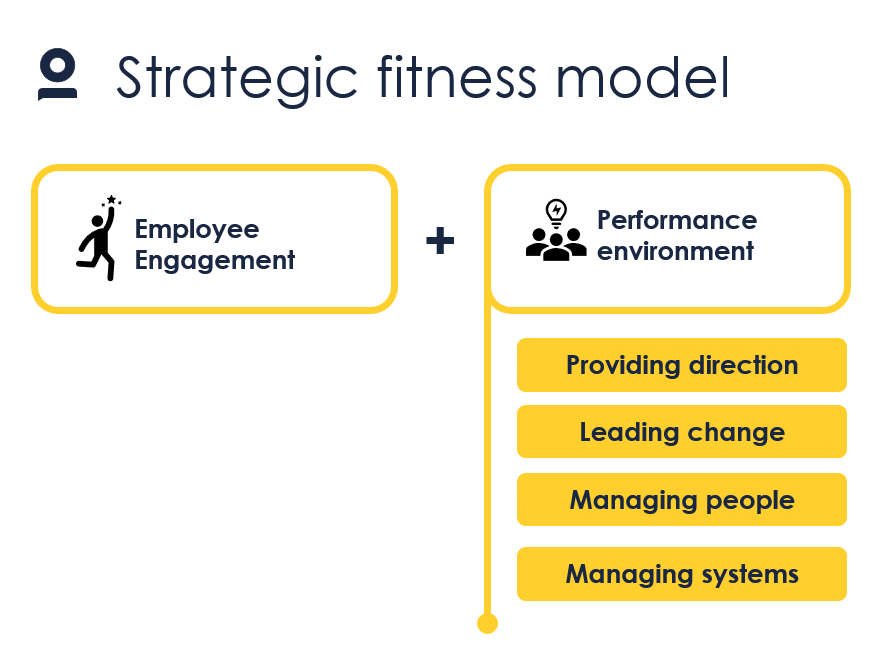The Strategic Fitness Model – What is it and what are the benefits?
The Strategic Fitness Model is a framework that measures an organization's fitness to achieve its goals. It provides employee feedback-based evidence to effectively address the processes of strategy implementation and organizational development. In this article, you will learn more about what Strategic Fitness is and the benefits it offers.
What does the Strategic Fitness Model entail?
Do you want to know what distinguishes organizations that succeed in dynamic environments? The Strategic Fitness Model is a scientifically validated tool that measures your organization's fitness to achieve its strategic ambitions. What’s more, the insights provided by the strategic Fitness Model are applicable across all cultures and countries, thanks to the unique international database the model is based on.
The Strategic Fitness Model identifies areas that need improvement to achieve organizational success, based on engagement and a performance environment. The survey consists of 22 questions. The Strategic Fitness Model is easy to use for CHRO's, HR practitioners and managers. It serves as a great basis for a questionnaire to measure key success factors.
Why Strategic Fitness?
The Strategic Fitness Model is a unique framework that:
- Provides clear insights into organizational strengths and areas for improvement.
- Helps align the organization on strategic issues while ensuring employee engagement.
- Is scientifically validated and easily applicable for HR practitioners and managers.
- Can be combined with other questions as part of an annual survey or conducted as a standalone survey.
- Allows for clear interpretation of insights based on internal and external benchmarks.
The Story Behind the SF Model
The theory behind the Strategic Fitness Model was developed in collaboration with the Ludwig-Maximilians University in Munich (LMU) and is based on a unique database sourced from more than 30,000 international scientific studies, with over 18 million respondents from nearly 50,000 organizations.
The Strategic Fitness Model is based on the following core message: Long-term success requires engaged employees in the right performance environment. The performance environment is determined by four crucial factors: providing direction, leading change, managing people and managing systems.
Organizations with an engaged workforce and a productive performance environment can achieve their strategic goals more easily and outperform those that lack either.

The Two Key Factors of Success
Long-term success requires engaged employees and the right performance environment. Engaged employees have a positive attitude towards their job and the organization. They are generally more productive and strive to improve themselves and the organization. And a good performance environment enables people to work effectively and efficiently.
Both elements are necessary: if employees are engaged but their efforts are misdirected, and their performance environment has shortcomings, it makes it impossible for the organization to fulfill its potential. If the performance environment provides the perfect conditions, but employees are somewhat alienated or disengaged, they will not contribute to the organization's success.
The 4 Pillars of Performance Environment
Four factors are crucial to the performance environment within an organization: providing direction, leading change, and managing people and systems.
Providing Direction: A company needs clear direction to stay on track for long-term success, particularly in dynamic markets. Clear direction helps the workforce get on board and become excited about the company's vision. Employees that are excited and on board will more easily go along with change driven by strategic demands.
Leading Change: Once the direction is clear, the organization has to be aligned to follow it. This requires good change-leadership and a cultural fit between employees and the organization.
Managing People: A positive culture that supports change and inspires confidence in management is crucial, especially in complex situations. People have to be briefed on how the direction and changes affect their jobs. They need to know what is to be done so they can apply their skills properly.
Managing systems: Organizational systems need to enable employees in the best way possible to deliver the performance that is expected of them. Examples of such organizational systems are the right digital tools, effective workflows, good collaboration and fitting opportunities for personal development.
Benchmarking
Effectory provides two types of benchmark data for comparison:
- External benchmarks – Based on your selection from Effectory’s extensive database of benchmark data, allowing you to compare your results with other organizations.
- Internal benchmarks – Comparative scores within your own organization, either as part of the organizational roll-up or through cross-comparisons of peer group scores.
Learn more about benchmarks here.
Reporting
The Strategic Fitness Model can be reported in two ways:
- Average scores (N.B. the PowerPoint currently has a mix of average and Top 2 Box scoring)
- Top 2 Box scores
See this article for a detailed explanation of the difference between these reporting methods.